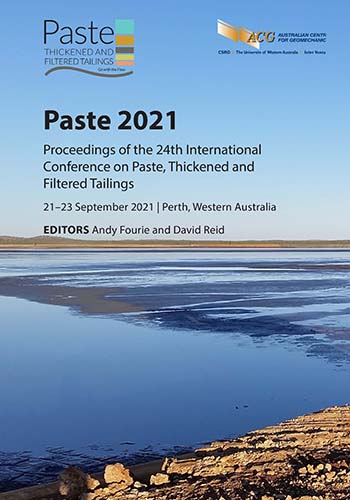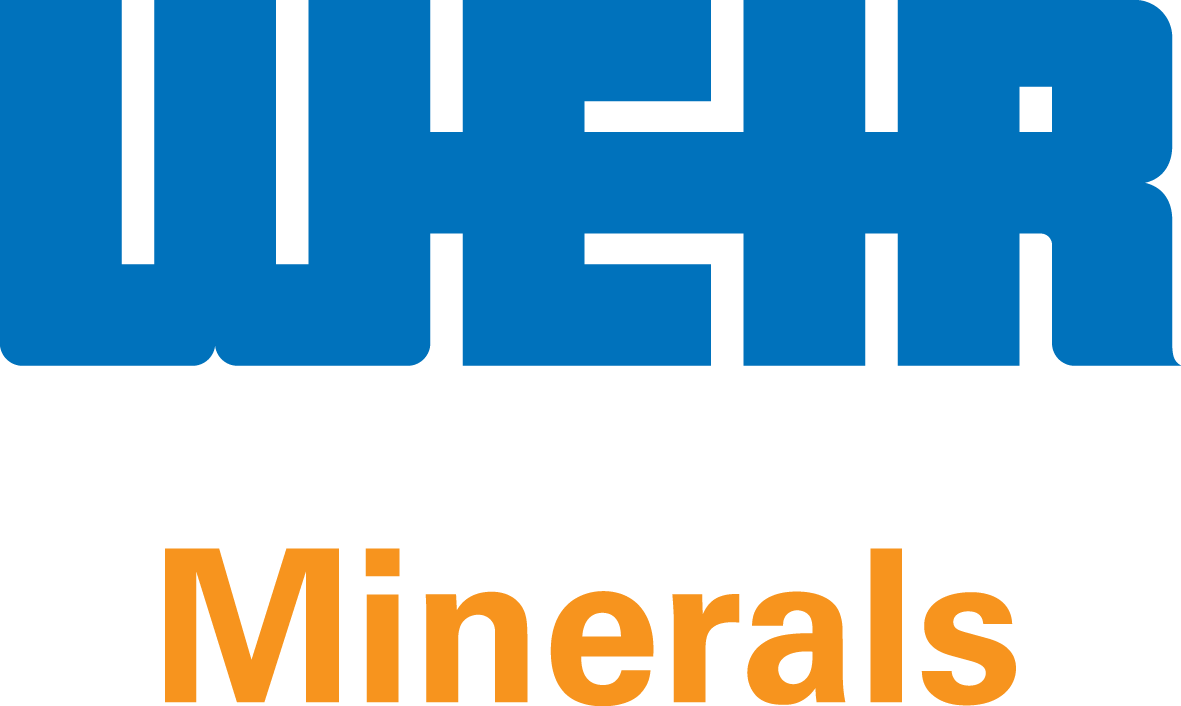Investigation of inhomogeneous properties of backfill samples to explore a new quantitative criterion for cemented paste backfill identification

|
Authors: Peng, XP; Guo, LJ; Liu, GS; Yang, XC; Wan, CC |
DOI https://doi.org/10.36487/ACG_repo/2115_28
Cite As:
Peng, XP, Guo, LJ, Liu, GS, Yang, XC & Wan, CC 2021, 'Investigation of inhomogeneous properties of backfill samples to explore a new quantitative criterion for cemented paste backfill identification', in AB Fourie & D Reid (eds), Paste 2021: Proceedings of the 24th International Conference on Paste, Thickened and Filtered Tailings, Australian Centre for Geomechanics, Perth, pp. 343-352, https://doi.org/10.36487/ACG_repo/2115_28
Abstract:
Cemented paste backfill (CPB) has been utilised globally in mines based on its benefits of non-segregation, non-bleeding and homogeneity. Due to a lack of research around the mechanism(s) driving anti-segregation properties, nowadays only some engineering empirical parameters including the slump or the fine particle content of backfill slurries can be used as the descriptive criterion for CPB. To better understand the antisegregation mechanism of CPB, so a quantitative criterion for its identification can be determined, the segregation-induced inhomogeneous properties of cemented tailings backfill have been experimentally investigated. Samples (diameter 75 mm and height 150 mm) with different solid contents were poured, cured and cut into sections of equal height. Thereafter, titration measures of EDTA-2Na and helium porosimeter have been used respectively to test the cement content and porosity of each section. Results show that the cement contents decreased from top to bottom along the curing height of samples, while the porosities increased along the settling direction. The inhomogeneity of cemented samples is affected obviously by the solids content of the paste, and it is notable that there is a turning point for the slurry concentration value over which the homogeneity will be improved dramatically. The turning point could be used as a new criterion for CPB definition from the perspective of inhomogeneity inhibition.
Keywords: cemented paste backfill, segregation, inhomogeneous properties, cement content, tailings
References:
Barrett, J 2000, ‘Paste fill development in Australia –lessons and surprises’, Paste Technology 2000 Seminar, Australian Centre for Geomechanics, Perth, pp. 13–14.
Belem, T & Benzaazoua, M, 2004, ‘An overview on the use of paste backfill technology as a ground support method in cut-and-fill mines’, in E Villaescusa & Y Potvin (eds.), Proceedings of the 5th International Symposium on Ground Support in Mining and Underground Construction, Tayler & Francis Group, London, pp. 637–650.
Belem, T & Benzaazoua, M 2008, ‘Design and application of underground mine paste backfill technology’, Geotechnical and Geological Engineering, vol. 26, no. 2, pp. 147–174.
Bentz, D, Ferraris, C, Galler, M, Hansen, A & Guynn, J 2012, ‘Influence of particle size distributions on yield stress and viscosity of cement-fly ash pastes’, Cement and Concrete Research, vol. 42, no. 2, pp. 404–409.
Benzaazoua, M, Fall, M & Belem, T 2004, ‘A contribution to understanding the hardening process of cemented pastefill’, Minerals Engineering, vol. 17, no. 2, pp. 141–152.
Cabrera, S, Bryan, J, Komishke, B & Kantzas, A, 2009, ‘Study of the settling characteristics of tailings using nuclear magnetic resonance technique’, International Journal of Mining, Reclamation and Environment, vol. 23, no. 1, pp. 33–50.
Chen, X, Yang, X, Guo, L & Peng, X 2018, ‘Experimental study on the determination of cement content in cemented tailings backfill’, Nonferrous Metals Engineering, vol. 8, no. 6, pp. 69–74.
Chen, X, Yang, X, Guo, L & Peng, X 2019, ‘Effect of curing age on the determination of cement content in cemented tailings backfill by EDTA titration method’, Nonferrous Metals Engineering, vol. 9, no. 4, pp. 93–99.
Cui, L & Fall, M 2016, ‘An evolutive elasto-plastic model for cemented paste backfill’, Computers and Geotechnics, vol. 71, pp. 19–29.
Ercikdi, B, Cihangir, F, Kesimal, A, Deveci, H & Alp, I 2009, ‘Utilization of industrial waste products as pozzolanic material in cemented paste backfill of high sulphide mill tailings’, Journal of Hazardous Materials, vol. 168, no. 2, pp. 848–856.
Grice, T 1998, ‘Underground mining with backfill’, Proceedings of the 2nd Annual Summit on Mine Tailings Disposal Systems.
Henderson, A, Revell, M, Landriault, D & Coxon, J 2005, ‘Paste fill’, in Y Potvin, E Thomas & A Fourie (eds), Handbook on Mine Fill, Australian Centre for Geomechanics, Perth.
Jiang, H & Fall, M 2017, ‘Yield stress and strength of saline cemented tailings in sub-zero environments: Portland cement paste backfill’, International Journal of Mineral Processing, vol. 160, pp. 68–75.
Li, S, Tang, D, Xu, H & Yang, Z 2012, ‘Advanced characterization of physical properties of coals with different coal structures by nuclear magnetic resonance and X-ray computed tomography’, Computers & Geosciences, vol. 48, pp. 220–227.
Loupasakis, C, Angelitsa, V, Rozos, D & Spanou, N 2014, ‘Mining geohazards-land subsidence caused by the dewatering of opencast coal mines: the case study of the Amyntaio coal mine, Florina, Greece’, Natural Hazards, vol. 70, no. 1 pp. 675–691.
Nasir, O & Fall, M 2010, ‘Coupling binder hydration, temperature and compressive strength development of underground cemented paste backfill at early ages’, Tunnelling and Underground Space Technology, vol. 25, no. 1, pp. 9–20.
National Energy Administration 2017, Chinese Oil and Gas Industry Standard (SY/T)5336-1996.
Pan, J, Zhang, Z, Li, M, Wu, Y & Wang, K 2019, ‘Characteristics of multi-scale pore structure of coal and its influence on permeability’, Natural Gas Industry B, vol. 6, no. 4, pp. 357–365.
Peng, X, Yang, X & Guo, L 2019, ‘Experimental study on the hindered settling process of backfill tailings’, Journal of China Coal Society, vol. 44, no. 5, pp. 1521–1526.
Peng, X, Yang, X & Guo, L 2020, ‘An experimental study on the hindered settling properties of backfill tailings particles’, in H Quelopana (ed.), Paste 2020: Proceedings of the 23rd International Conference on Paste, Thickened and Filtered Tailings, Gecamin Publications, Santiago,
Potvin, Y 2005, ‘Introduction’, in Y Potvin, E Thomas & A Fourie (eds), Handbook on Mine Fill, Australian Centre for Geomechanics, Perth.
Potvin, Y, Thomas, E & Fourie, A (eds) 2005, Handbook on Mine Fill, Australian Centre for Geomechanics, Perth.
Sheshpari, M 2015, ‘A review of underground mine backfilling methods with emphasis on cemented paste backfill’, Electronic Journal of Geotechnical Engineering, vol. 20, no. 13, pp. 5183–5208.
Siddique, T, Gupta, R, Fedorak, P, MacKinnon, M & Foght, J 2008, ‘A first approximation kinetic model to predict methane generation from an oil sands tailings settling basin’, Chemosphere, vol. 72, no. 10, pp. 1573–1580.
Sivakugan, N, Veenstra, R & Naguleswaran, N 2015, ‘Underground mine backfilling in Australia using paste fills and hydraulic fills’, International Journal of Geosynthetics and Ground Engineering, vol. 1, no. 2, pp. 1–7.
Sofrà, F 2017, ‘Chapter 3: rheological properties of fresh cemented paste tailings’, in E Yilmaz & M Fall (eds), Paste Tailings Management, Springer, Cham.
Stone, D 2014, ‘The evolution of paste for backfill’, in Y Potvin & T Grice (eds), Proceedings of the Eleventh International Symposium on Mining with Backfill, Australian Centre for Geomechanics, Perth, pp. 31–38,
ACG_rep/1404_0.3_Stone
Verkerk, C & Marcus, R 1988, ‘The pumping characteristics and rheology of paste fills’, Backfill in South African Mines, pp. 221–233.
Wu, A, Wang, Y& Wang, H 2016, ‘Status and prospects of the paste backfill technology’, Metal Mine, vol. 45, no. 07, pp. 1–9.
Yilmaz, T & Ercikdi, B 2016, ‘Predicting the uniaxial compressive strength of cemented paste backfill from ultrasonic pulse velocity test’, Non-destructive Testing and Evaluation, vol. 31, no. 3, pp. 247–266.
Zeng, B, Zhang, Z & Yang, M, 2018, ‘Risk assessment of groundwater with multi-source pollution by a long-term monitoring programme for a large mining area’, International Biodeterioration & Biodegradation, vol. 128, pp. 100–108.
© Copyright 2025, Australian Centre for Geomechanics (ACG), The University of Western Australia. All rights reserved.
View copyright/legal information
Please direct any queries or error reports to repository-acg@uwa.edu.au
View copyright/legal information
Please direct any queries or error reports to repository-acg@uwa.edu.au





